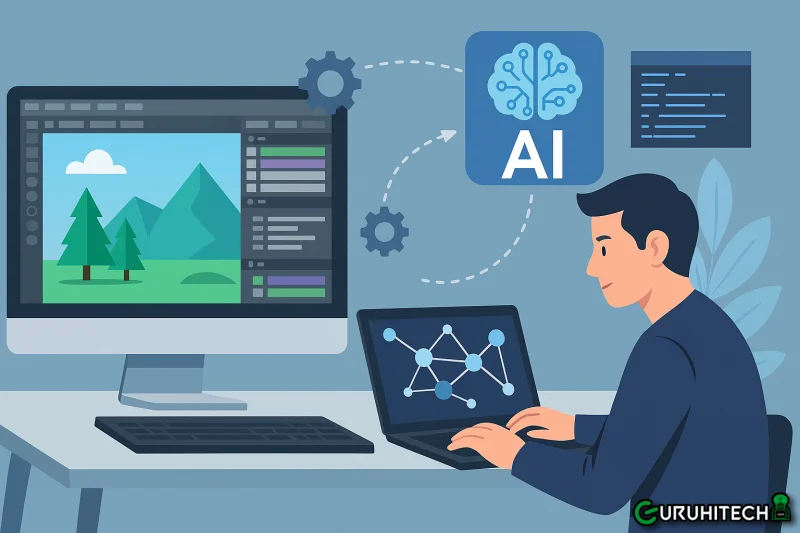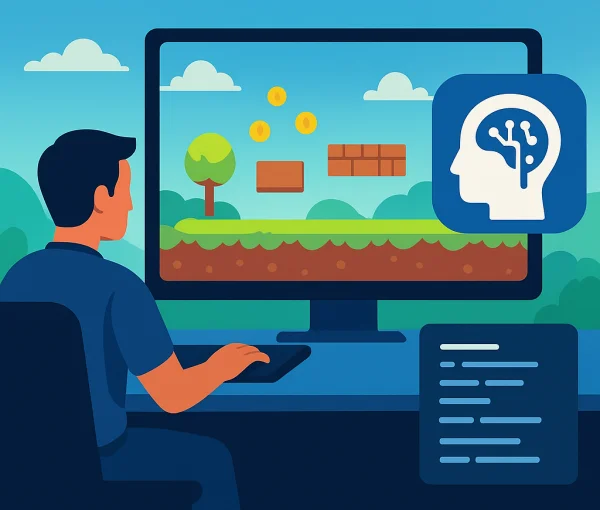How Game Engines Integrating AI for Smarter Workflows

The gaming industry has always been at the forefront of technological innovation, constantly evolving to push the boundaries of creativity and immersion. Over the years, game engines have transformed from simple rendering tools into sophisticated ecosystems that empower creators to build expansive, lifelike worlds. Now, with the rapid rise of artificial intelligence (AI), a new chapter in game development is unfolding. AI isn’t just making games more intelligent; it’s fundamentally reshaping how they’re made. From automating design processes to personalizing gameplay experiences, Astrocade is revolutionizing workflows and redefining the role of developers in crafting the future of interactive entertainment.
The Shift in Game Development
Traditionally, game development was a resource-intensive process requiring large teams of programmers, artists, and designers working in tight coordination. Each element, whether a 3D model, sound effect, or animation, had to be meticulously handcrafted. As the industry matured, tools and engines evolved to streamline these tasks, enabling faster iteration and more accessible creation. However, the arrival of AI has introduced an even more profound transformation. Developers are now leveraging intelligent systems to generate art, environments, narratives, and even gameplay mechanics in real-time. This shift has redefined productivity, making it possible for smaller teams or even solo creators to produce high-quality, dynamic games that once demanded massive studios.
What Are Game Engines? A Brief Overview
Game engines serve as the backbone of modern game development. They provide the software framework that enables developers to build, test, and deploy games across multiple platforms. Core components of a game engine include rendering systems, physics engines, animation tools, and scripting interfaces. Over time, engines have evolved from basic graphics libraries into comprehensive development environments, offering built-in editors, asset management tools, and integration with external software. With the advent of AI, these engines are becoming even more versatile, empowering creators not just to build games but to teach their games how to think, adapt, and evolve alongside the player.

The Role of AI in Game Design
AI has become a cornerstone of modern game design, revolutionizing aspects like procedural generation and adaptive storytelling. In the past, AI was limited to basic functions such as enemy pathfinding or simple decision-making. Now, it drives sophisticated systems that analyze player behavior, anticipate actions, and deliver tailored experiences. Advanced AI algorithms can craft unique levels, simulate lifelike non-player character (NPC) behavior, and dynamically adjust difficulty to match individual skill levels. For narrative-driven games, machine learning enables dynamic dialogue creation and storyline adjustments based on player choices, enhancing replayability and emotional depth. Explore these innovations in action with titles like house of guinness game, where adaptive challenges shine, or try AstroManager, which showcases AI-driven management gameplay.
Key Features of Modern Game Engines
Modern game engines are increasingly integrating AI-driven tools to enhance creativity and efficiency. Key features include:
- Procedural Generation: AI can automatically create landscapes, levels, or entire worlds, saving time while maintaining diversity and uniqueness.
- Smart Asset Management: AI helps organize and tag assets, enabling developers to quickly find and reuse components across projects.Automated Testing: Machine learning algorithms simulate player behavior to detect bugs and optimize gameplay mechanics without manual testing.
- Adaptive Lighting and Animation: AI assists in creating realistic lighting effects and natural character animations that respond dynamically to environments.
- Real-Time Optimization: Engines now use AI to analyze performance data and automatically adjust rendering for smoother gameplay across different devices.
These features are turning game engines into intelligent collaborators—partners that can assist, suggest, and even create alongside human developers.
How AI Enhances Game Development Workflows
AI integration has streamlined many aspects of game development, reducing repetitive tasks and enabling teams to focus on creativity. For instance, AI-powered tools can generate environmental assets such as rocks, trees, and terrain with a single click, allowing artists to spend more time refining visual details. Procedural animation systems ensure characters move fluidly and react authentically, cutting down on manual keyframing. AI is also improving game balancing and testing. Predictive algorithms can simulate millions of gameplay scenarios, helping developers fine-tune difficulty and pacing before release. In short, AI game development has transitioned from a manual, linear process into an intelligent, iterative one where data and creativity merge seamlessly.
Real-World Examples of AI in Gaming
AI-driven advancements are already reshaping both indie and AAA development. Some studios use neural networks to generate realistic textures and environmental details, eliminating the need for extensive manual design. Others employ machine learning for procedural world-building, enabling games to generate endless variations of landscapes or levels. In action or role-playing games, AI systems analyze player decisions to create responsive narratives that evolve over time. Meanwhile, simulation games benefit from AI-driven economies and ecosystems that mirror real-world complexity. Beyond development, AI is also being used to enhance in-game experiences—creating smarter NPCs, more adaptive opponents, and even real-time voice synthesis that allows characters to speak dynamically generated lines.
Challenges in Integrating AI into Engines
Despite its transformative potential, integrating AI into game engines comes with challenges. One major concern is creative control—ensuring that AI-generated content aligns with the artistic vision of the development team. While AI can accelerate production, it may also produce results that feel generic or lack emotional depth without careful guidance. Technical complexity is another hurdle. Implementing AI requires data management, model training, and computational power, which can be demanding for smaller studios. Additionally, ethical considerations such as data privacy, content ownership, and bias in AI-generated material are emerging concerns. Balancing automation with authenticity and responsibility will be critical as AI continues to evolve within game development.
The Future of Game Engines and AI
Looking ahead, the fusion of AI and game engines is expected to usher in an era of unprecedented creativity and interactivity. We can anticipate engines capable of fully autonomous world generation—where developers simply describe a concept and watch it come to life in real-time. AI companions may assist developers in debugging, optimizing, or even brainstorming design ideas. For players, this evolution will result in experiences that adapt dynamically, offering personalized challenges, emergent storytelling, and evolving virtual worlds. Cloud-based AI systems will further democratize access, allowing creators anywhere in the world to build games collaboratively without massive infrastructure investments.
Embracing Change in Game Development
The integration of AI into game engines marks a pivotal moment in the evolution of digital entertainment. As technology continues to advance, the line between creator and creation will blur further, empowering developers to push beyond traditional boundaries. Embracing AI doesn’t mean replacing human creativity—it means amplifying it. By automating repetitive tasks and offering intelligent insights, AI allows artists, designers, and programmers to focus on what truly matters: imagination, innovation, and storytelling. The future of game development belongs to those who see AI not as a tool, but as a creative partner—one that helps turn ideas into living, breathing worlds faster and more beautifully than ever before.
Ti potrebbe interessare:
Segui guruhitech su:
- Google News: bit.ly/gurugooglenews
- Telegram: t.me/guruhitech
- X (Twitter): x.com/guruhitech1
- Bluesky: bsky.app/profile/guruhitech.bsky.social
- GETTR: gettr.com/user/guruhitech
- Rumble: rumble.com/user/guruhitech
- VKontakte: vk.com/guruhitech
- MeWe: mewe.com/i/guruhitech
- Skype: live:.cid.d4cf3836b772da8a
- WhatsApp: bit.ly/whatsappguruhitech
Esprimi il tuo parere!
Ti è stato utile questo articolo? Lascia un commento nell’apposita sezione che trovi più in basso e se ti va, iscriviti alla newsletter.
Per qualsiasi domanda, informazione o assistenza nel mondo della tecnologia, puoi inviare una email all’indirizzo [email protected].
Scopri di più da GuruHiTech
Abbonati per ricevere gli ultimi articoli inviati alla tua e-mail.
